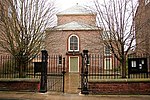York

York is a cathedral city in North Yorkshire, England, with Roman origins, sited at the confluence of the rivers Ouse and Foss. It is the historic county town of Yorkshire. The city has many historic buildings and other structures, such as a minster, castle, and city walls. It is the largest settlement and the administrative centre of the wider City of York district. The city was founded under the name of Eboracum in 71 AD. It then became the capital of the Roman province of Britannia Inferior, and later of the kingdoms of Deira, Northumbria, and Scandinavian York. In the Middle Ages, it became the northern England ecclesiastical province's centre, and grew as a wool-trading centre. In the 19th century, it became a major railway network hub and confectionery manufacturing centre. During the Second World War, part of the Baedeker Blitz bombed the city; it was less affected by the war than other northern cities, with several historic buildings being gutted and restored up to the 1960s.The city is one of 15 in England to have a lord mayor, and one of three to have The Right Honourable title affixed, the others being London's and Bristol's. Historic governance of the city was as a county corporate, not included in the county's riding system. The city has since been covered by a municipal borough, county borough, and since 1996 a non-metropolitan district (the City of York), which also includes surrounding villages and rural areas, and the town of Haxby. The current district's local council is responsible for providing all local services and facilities throughout this area. The city had a population of 153,717 in the 2011 census; the wider district had a population of 198,100. According to 2021 census data, the wider district has a population of 202,800, a 2.4% increase compared to the 2011 census.
Excerpt from the Wikipedia article York (License: CC BY-SA 3.0, Authors, Images).York
St Saviourgate, York Bishophill
Geographical coordinates (GPS) Address Nearby Places Show on map
Geographical coordinates (GPS)
| Latitude | Longitude |
|---|---|
| N 53.960106 ° | E -1.078017 ° |
Address
St Saviourgate
YO1 8NQ York, Bishophill
England, United Kingdom
Open on Google Maps










